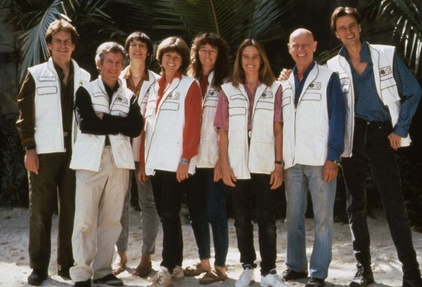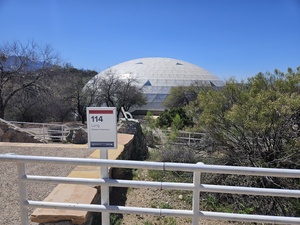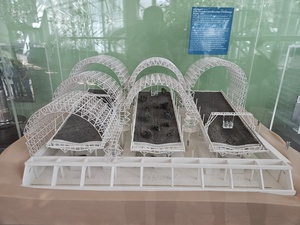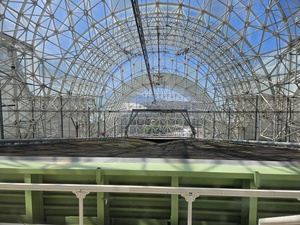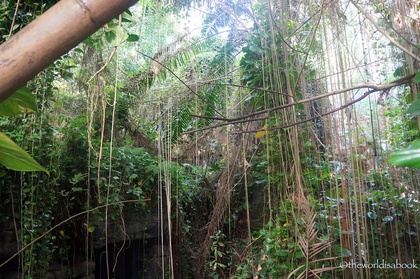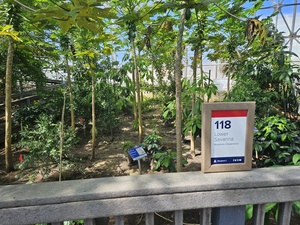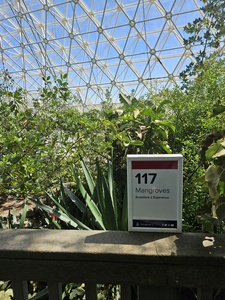About
Biosphere 2 is an Earth systems science research facility, created with the mission to serve for research, outreach, teaching, and life-long learning about Earth, its living systems, and its place in the universe, currently supported by the University of Arizona's College of Science.[1] Located north of Tucson, near Oracle, this facility is surrounded by a natural desert terrain and elevated 4,000 on a cool ridge. Named one of the "50 Must See Man-Made Wonders of the World" by Time Life Books, this specially-designed mini world allows for real-time research on the future of our planet, housing five distinct simulated ecosystems. Remaining the largest closed system ever created, it features a rainforest, an ocean with a coral reef, mangrove wetlands, savanna, and a fog desert, in addition to a separate agricultural system and human habitat, all contained within a tightly sealed glass and steel structure over a 3.14-acre area.
Mission
Its mission is to serve as a center for research, outreach, teaching and life-long learning about Earth, its living systems, and its place in the universe; to catalyze interdisciplinary thinking and understanding about Earth and its future; to be an adaptive tool for Earth education and outreach to industry, government, and the public; and to distill issues related to Earth systems planning and management for use by policymakers, students and the public. (Biosphere2.org)
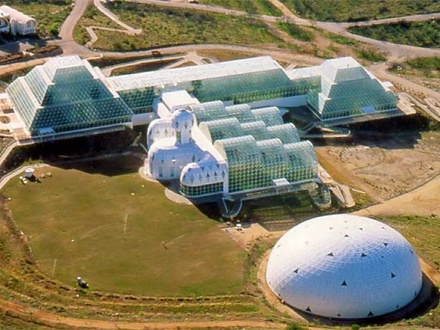 The five sealed biomes, along with attached crew quarters and agricultural area, and one of the two "lungs" used to maintain air pressure within the enclosed system
The five sealed biomes, along with attached crew quarters and agricultural area, and one of the two "lungs" used to maintain air pressure within the enclosed system
History
The vision for Biosphere 2 came from American engineer John P. Allen, who purchased the land used for the Biosphere in 1984 as the director of Space Biospheres Ventures. Construction began in 1987, with the purpose of the Biosphere originally being to serve as a model environment for the development of self-sufficient technologies for space colonization, and ended in 1991. Its title "Biosphere 2" reflects this, it being intended to be the second self-contained ecosystem after Earth itself.[2]
The Missions
On September 26, 1991, eight researchers, known as “biospherians,” sealed the airlock on this massive enclosed ecological system, their goal being to test the feasibility of surviving in such an environment without outside support. To do so, it would be necessary not only for them to grow their own food and maintain their own equipment, but also to find ways to efficiently recycle their waste and find the time to perform their own ecological research. This team consisted of four men and four women aged between 29 and 69, hailing from a diversity of backgrounds including botany, agriculture, marine ecology, physiology, engineering, communications.
Unfortunately, this mission would run into a variety of problems, which would go on to seriously impact the public image of Biosphere. Hunger was a significant problem, with crop yields being lower than expected due to an early winter outside the dome, which limited the amount of sunlight the plants could receive, and the farm animals, chickens and pigs, they brought in having consumed more food then they were providing the crew. As a result, some of the team resorted to opening the emergency stocks or eating the seeds meant for agriculture themselves, while others were rumored to have smuggled in food from the outside, which, if true, would've seriously damaged the credibility of the experiment. In the process of the experiment, the team would eventually split into two, bitterly hostile groups, which damaged their ability to cooperate and negatively impacted the stress levels of all the participants. The final nail on the coffin for the experiment's credibility would be, however, the drop in oxygen levels, which forced the facility to inject air from the outside. Despite these issues, the experiment continued until September 26, 1993, in which they finally, officially, left the Biosphere after being contained for two years.[3]
In March 26, 1994, a second mission began, aimed at a ten month duration with a new crew of seven individuals. Despite the crew initially showing promising results concerning their ability to remain self-sufficient, having learned from some of the mistakes of the project's first iteration, outside factors would eventually cause this mission to collapse. These included issues with management, financial expenditures, and accusations of sabotage by two members of the original mission crew. As a result, no further missions would be conducted, and the Biosphere would change its focus from creating a completely self-sustaining environment to conducting ecological experiments in a controlled setting.[4]
The Results
Much of the public and the scientific community had a negative reaction to the results of both experiments. Throughout the project's existence, it was subjected to intense media interest and closely monitored by the outside world, which may have played a substantial role increasing the tensions within the team and their management. Many headlines focused on the potential compromises with the project's integrity, including the introduction of foreign materials, such as equipment, food, and oxygen. Others were concerned that the experiment did little to prove the viability of self-sufficient environments, and produced little valuable research on its own.
Some however, were more idealistic. Mark Nelson, a Biospherian from the first crew, believed that the project was successful, and called it "the greatest experiment ever conducted in ecological self-organization," saying it "revolutionized the field of experimental ecology." Others noted that it proved a good opportunity to observe the psycho-social aspects of such self-sufficient colonies, with the isolated crew mates being subject to most of the pressures that would be faced by a team forced to fend for themselves in a harsh, unforgiving environment.[5]
Biosphere 2 Today
After the failed second mission, a deal was made with Columbia University in 1995 to use the facility to study the effects of global warming, particularly the impact that CO2 has on the soil in an ecosystem and its impact on the acidity levels in the ocean, studies which made good use of Biosphere 2's closed system. Despite this, the facility's bad press made it difficult for it to attract grants, which led to Columbia walking out on its lease in 2003, and the University of Arizona taking it over in 2007, which it holds to this day.[4] Current research involves the impacts of drought and high temperature on plants as a consequence of climate change, and finding novel uses for renewable energy in the form of using solar power generators to grow plants.[8]
Structure
Biosphere 2's glass and space frame structure measures seven million cubic feet in volume and stretches up to eighty-five feet at its highest point. Visually, the structure evokes the image of the geodesic domes envisioned by famous environmentalist and futurist Buckminster Fuller. Befittingly, it was designed and constructed by one of his associates, Peter Jon Pearce. Its steel struts are covered with a finish that protects against corrosion from both inside or outside the biosphere, and is sealed to be extremely airtight, with a leakage rate of less than 10% a year. All air, water, and nutrient cycles are completely closed and recycled within this system.
The monitoring of climate, air, soils and water within Biosphere 2 is unprecedented. Over 1,000 sensors distributed throughout the Biosphere send information to the sophisticated monitoring and control system located on-site at Mission Control. This elaborate computer network provides a continuous display of environmental variables and the status of engineering controls – while constantly updating the permanent database.[6]
To maintain a constant air pressure within the structure, which would otherwise expose it to the risk of explosion or implosion, two domes, known as "lungs", are attached to the system by a series of underground tunnels. These lungs contain heavy rubber membranes which expand and contract in response to outside changes in temperature. Below the south lung exists a collection tank for the water produced through condensation within the system.
In order to maintain and power all of this, Biosphere 2 has its own Energy center. Without power, temperatures could reach dangerous highs in less than 20 minutes. Currently, the Biosphere uses 2 different generators. The primary generator uses natural gas and the backup generator uses diesel fuel. This way if one goes down of one fuel source is no longer available they can still keep all of their critical infrastructure running. In addition to the generators, there are boilers to heat water and chillers to cool water. 3 cooling towers are also used to cool the air that gets piped into the Biosphere (Biosphere 2 audio tour).
The Human Habitats
 The outside of the human habitat
The outside of the human habitat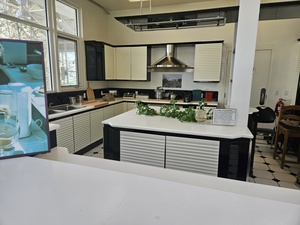 The communal kitchen
The communal kitchen
The living space inside the Biosphere 2 was a 25,000-square-foot, five-story structure. There was a communal kitchen, a command room with personal offices, laboratories, storage areas, a medical lab, a library, and everyone had a personal apartment (Biosphere 2 audio tour).
The Library
The library was located at the tallest point in the building. This room provided its inhabitants with a 360-degree view of the outside world. Unfortunately, The Biosherians did not use the library much because the only way to access it was by going up a long long spiral staircase (Biosphere 2 audio tour).
The Orchard
The original Biosherians referred to this space as “the sweets shop.” Here they grew figs, bananas, lemons, limes, and coffee. Unfortunately for Biosherians, they were only able to produce and process enough coffee to have one cup every few weeks. They also used the bananas to make banana wine since they did not bring in any alcohol from the outside world (Biosphere 2 audio tour).
Landscape Evolution Observatory (LEO)
LEO is an experiment added on by the University of Arizona inside what used to be the agricultural biome. The goal of this experiment is to see how water moves down mountainsides and underground. They are also testing for what impacts the quality of the water as the land changes. It’s incredibly difficult to understand the behavior and composition of water once it is below the earth's surface. As of 2023, there are no plants on the slopes of LEO but researchers are planning to add some in the near future in order to test how adding complexity changes the dynamics of the water cycle (Biosphere 2 audio tour).
The Seven Biomes
Included in the ecological systems of Biosphere 2 are an ocean, a tropical rainforest, a savannah, a marsh, and a desert.Each different biome was built from scratch – with carefully selected soils, water and plant and animal life, collected from all offer the world. Biosphere 2 sustains high biodiversity with approximately 3,800 living species within its glass walls. The animal residents of the biomes were chosen by the captain of each biome. No large predators were allowed, and many species were rejected because their needs were greater than the scale of Biosphere 2 could support. Hummingbirds were an easy choice because they are surprisingly hardy and are excellent pollinators. Bees, bats, moths, and butterflies were also brought in as pollinators. About 40 land dwelling species included snakes, reptiles, and turtles. The resident mammals were bats and bushbabies. Of Earth's thousands of species of insects, ants, termites and cockroaches were chosen to share the habitat because they break down dead plants and animals into recyclable materials that benefit the Biosphere. Oysters and crabs were brought in to populate the replica ocean. Even a small coral reef was incorporated in the Biosphere 2 ocean. The plants were equally important and included medicinal plants, the agave, the jojoba, rubber trees, mosses, ferns, and trees that produce gums and soaps. Plants and animals that were imported into the United States were quarantined before being allowed in Biosphere 2.
Rainforest
The Rainforest mesocosm, at the north end of Biosphere 2, was created to simulate several tropical Rainforest habitats. The biome can be divided into the following habitats:
- Lowland rainforest includes most of the eastern part of the biome. It is dominated by large trees with a ground layer of aroids.
- Terraces surround the east, west and north sides of the central "mountain." Small trees including papaya, coffee, and palms are in these areas.
- Ginger belts contain fast-growing large monocots such as banana, gingers, and bird-of-paradise to reduce lateral radiation from outside.
- Bamboo belt of dense bamboo species was intended to screen the biome from airborne salt that might be entrained from the ocean biome.
- Varzea, intended to simulate an Amazonian seasonal floodplain, is located in the southwest corner of the biome.
- Tepui (Cloud forest) was designed to simulate a highland cloud forest. Due to high temperatures vegetation evolved into a marsh dominated by umbrella sedge and morning glory vines.
Initially, about 300 species of plants were introduced with an emphasis on neotropical species and plants used by indigenous people. Dominants among the surviving plant species (less than 100), include Clitoria racemosa, Ceiba pentandra, Musa spp., Arenga pinnata, Epipremnum pinnatum, Syngonium podophyllum, and Cissus sicyoides. The dominant species have changed since initial assembly due to both managerial and ecological factors. One managerial influence occurred in the early years; Leucaena leucocephala, a fast growing legume tree species, was planted throughout the biome to shade the newly planted seedlings. This species was removed in early 1994 to give room for other tree species. (Biosphere2.org)
Ocean
The Biosphere 2 Ocean provides a unique opportunity to develop, test, and deploy solutions to the coral reef crisis.
The Biosphere 2 marine mesocosm is a totally enclosed system and was originally designed to simulates a Caribbean reef. It is a large tank with a surface area of 35x20 m, from 7 m deep grading to a shallow lagoon partially separated by a fringing reef. The total water volume of this mesocosm is 2.6 million liters. Mechanical systems simulate or substitute for natural environmental processes. Physical and chemical parameters such as mixing, gas exchange, nutrient concentrations, and partial pressure of CO2 can be independently manipulated. The Biosphere 2 ocean is ideal for testing models of chemical or biological changes on coral reefs. The core experiment conducted in this facility was to measure the rates of photosynthesis and calcification for three states of the system. One corresponding to full glacial time (CO2 = 200µatm, CO3 = 355 µmol/kg, pH 8.29), a second to the present day conditions (CO2 = 360 µatm, CO3 = 241 µmol/kg, pH = 8.08) and a third to conditions predicted for the 22nd Century (CO2 = 900µatm, CO3 = 174 µeq/kg pH = 7.89. These conditions were alternated at 3-month intervals over a three year period. Results from Langdon et al (2000) have shown that rates of coral skeleton calcification decline by 40 % under seawater carbonate concentrations in equilibrium with CO2 in the mid 21st Century atmosphere.
Biosphere 2 is now revitalizing the ocean to create a coral reef tank entirely dedicated to research. It will host diverse physical environments: a turbulent fore-reef with 6-7m vertical relief; a reef crest and back reef with ~2m relief; and a large 1-2m lagoon with diverse substrates. Light, flow, and chemistry will be maintained by a new generation of equipment to be installed in 2018. (Biosphere2.org)
Savanna
The savanna biome was designed to perform several different functions within Biosphere 2. Its primary goal was to provide a hydrological transition zone between the desert and rainforest mesocosms. The objective was to learn how to balance atmospheric chemistry by varying hydrological regimes within the tropical mesocosms. The savanna was to be a scaled-down model of tropical savannas, both duplicating ecosystem processes in savannas and capturing essential features of biodiversity and aesthetics. Vegetation zones within the savanna mesocosm were created primarily from edible species, including acacias for galagos, large-seeded grasses for finches, and fruit-bearing trees for galagos and birds. (Biosphere2.org)
Mangrove
The Mangrove mesocosm is comprised of two major wetland types: 1) a small area of marshes dominated by grass species and 2) forested swamps dominated by mangrove trees, covering 80% of the mesocosm. 542 mangroves and 15 freshwater trees were originally present in the mesocosm’s 441 m2 area. This estuarine model is composed of six adjacent sections. Walls between each section are reinforced with steel rebar and have 0.6 m-wide notches, which permit movement of animals and water between sections. To maximize species diversity, different community types were constructed in each of the six sections. (Biosphere2.org)
This biome is currently being used by the University of Arizona’s ecology department to research various fish species that would live in this environment. All of the first mangrove trees in this area were carefully transported from Florida (Biosphere 2 audio tour).
Coastal Fog Desert
 Coastal fog desert stop
Coastal fog desert stop Coastal fog desert
Coastal fog desert
Biosphere 2's desert biome was designed to simulate an arid desert scrub ecosystem in a coastal climate with erratic winter rainfall and summer drought such as Baja. Excessive rain and relatively low evapotranspiration during the initial two-year closure resulted in a dense scrub invaded by grasses. Conversion to a Mediterranean scrub woodland was initiated in 1994, but subsequently climate parameters were changed to simulate more arid conditions. Current management practices are intended to favor arid-adapted species and discourage grasses with C4 photosynthetic pathways. (Biosphere2.org)
Thornscrub
This is the transition zone between the desert and the tropical regions in the upper parts of the biosphere. This is a summer active zone that was originally meant to produce oxygen in the summertime while the fog desert produces oxygen in the wintertime. Most of the plants in this area were brought in from places like Mexico and Madagascar (Biosphere 2 audio tour).

Visiting and Tours
The Biosphere 2 houses real time earth science and research along with a visitor center that has movies, exhibits, cafe and bookstore and is open daily. The Biosphere is kid friendly with fences and railings making it safe for families to come and enjoy all the science and learning they provide for visitors. To ensure the safety of the ecosystem they also limit you to certain areas you can and cannot consume food in hopes of keeping the biomes clean and limiting their exposure to outside contaminants. Tours consist of a walk through each of the biomes, including a visit to the crew's habitat area and the supporting lung structures. The guides give visitors an overview of the facility and its purpose, along with a brief history of the original two missions. In addition, a "virtual tour" is available through their website which allows users to view panoramic displays of the interior and exterior of the structure from several points, similar to Google's StreetView system.
Its mission is to serve as a center for research, outreach, teaching and life-long learning about Earth, its living systems, and its place in the universe; to catalyze interdisciplinary thinking and understanding about Earth and its future; to be an adaptive tool for Earth education and outreach to industry, government, and the public; and to distill issues related to Earth systems planning and management for use by policymakers, students and the public.
Tickets
General Admission tickets are available online. Currently (2023) The Biosphere offers an app-guided audio tour that will lead guests through the history and the current research in these facilities. In addition to General Admission, you can purchase tickets to the Lung Tour for an additional $10 per person. This behind-the-scenes tour will lead guests through the “lungs” that regulated the air pressure inside Biosphere 2. For more (and the most up-to-date) information please visit https://www.biosphere2.org/visit/visit-biosphere-2/self-guided-tour.
Pricing:
Adult - $25
Child (5-17) - $15
Senior (Ages 62 and above) - $23
Military Adult - $23
UA Student/Faculty (must present CatCard) - $20
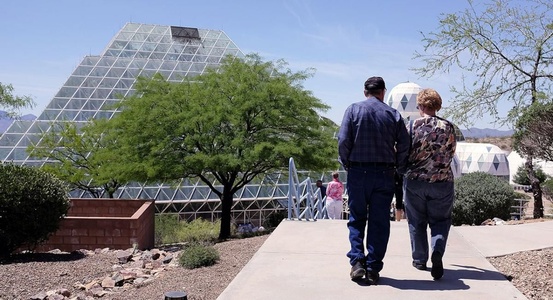 Outside of the Biosphere, the Rainforest biome is contained within the pyramid
Outside of the Biosphere, the Rainforest biome is contained within the pyramid Inside the Biosphere, with the Ocean biome visible
Inside the Biosphere, with the Ocean biome visible
Biophere 2's Legacy and Popular Culture
Although Biosphere 2's legacy as a scientific experiment is one marred by accusations of failure, poor public relations, and concerns about its cost effectiveness, one thing Biosphere 2 did succeed in doing was capturing the imaginations of many. As the topic of space exploration and colonization as seen a recent surge in popularity, with films such as The Martian (2015) attracting box office success and the commitment of famous futurist and inventor Elon Musk to developing long-term habitats on Mars sparking widespread interest, Biosphere 2 is increasingly referenced, in both a positive and negative light, as a possible model for such experiments.[7] Biosphere 2 has also been referenced or parodied in films such as Bio-Dome (1996), a comedy with environmentalist themes, and in the novel Terranauts (2016), by American novelist T.C. Boyle, which presents a fictionalized account of the first mission.
Further Reading
[2]- https://www.britannica.com/topic/Biosphere-2
[3]- http://blogs.britannica.com/2011/09/years-glass-biosphere-2-mission
[4]- http://discovermagazine.com/2010/oct/20-life-under-the-bubble
[5]-https://dartmouthalumnimagazine.com/articles/biosphere-2-what-really-happened
[6]- http://www.biospherics.org/biosphere2
[7]- https://www.businessinsider.com/biosphere-two-pictures-tour-2018-4
[8]- https://experts.arizona.edu/biosphere-2
<div> </div>
</div>

